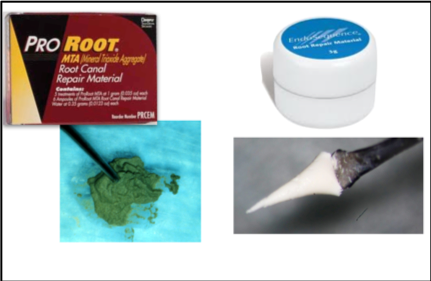A bioceramic is a substance or material intended to be implanted in a living organism to replace, reconstruct or even restore an organ or tissue. The use of bioceramics dates back to the 1800s when plaster of Paris was used to fill bone defects. Today, bioceramics are used routinely in medicine, especially in orthopedic surgery as an orthopedic prosthesis, or in craniofacial surgery as an ocular prosthesis or for total mandibular replacement. (Figure 1)
- Figure 1
Figure 1
In Endodontics, bioceramics were first introduced with the advent of MTA in the 1990s (Figure 2). Subsequently, several products have been developed based on the composition of the MTA. MTA, an acronym for Mineral Trioxide Aggregate, is simply ultra-purified Portland cement with added opacifying products. Other bioceramic products exist today in Endodontics, notably the Root Repair Material (RRM) family (Figure 2). One of the key differences between MTA and RRM is that RRM is a ready-to-use product, making the clinical procedure easier and faster, while MTA requires mixing with water, and making sure the right texture is obtained before its application.
- Figure 2: MTA (g), RRM (d)
Figure 2: MTA(g), RRM(d)
However, it is the biological properties that make bioceramics a desirable product in Endodontics. It has been shown in several studies that bioceramics are biocompatible, non-cytotoxic, antimicrobial, and bioactive, hence capable of initiating the appropriate biochemical reactions so that stem cells can divide, multiply and reorganize into a dental tissue. In addition, bioceramics are hydrophilic dental materials, making them ideal for periapical and periradicular applications.
Here are some of the examples of modern bioceramics application in Endodontics:
- Perforation and resorption repair
- Treatment of immature apices (apexification and apexogenesis)
- Pulpotomies and pulp capping
- Root canal sealer
Are you interested in discovering the clinical protocols covering bioceramic applications?
Dr. Safi is offering 2 courses covering this topic.
- Les accidents iatrogéniques en endodontie : prévention et traitement
- Endodontic treatment of immature permanent teeth
Do you have questions about a case that you encountered or suggestions for future courses? Write to us at info@endostlaurent.ca and we will be happy to help you.

